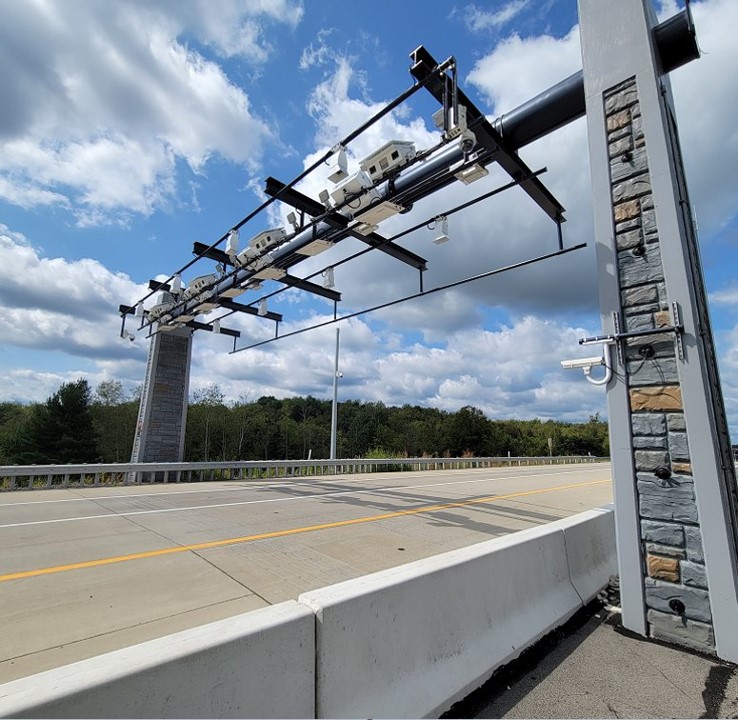Top 5 Things to Know About Open Road Tolling on the PA Turnpike

The Pennsylvania Turnpike (PA Turnpike) is preparing to launch one of the most significant changes to its operations in its nearly 84-year history. In January 2025, Open Road Tolling (ORT) launches East of Reading and on the Northeast Extension, with the rest of the system adopting the change two years later in 2027.
So, what does this mean for customers? Here are five things to know.
ORT Changes Where Customer are Tolled
Tolls are charged electronically as customers drive without slowing down or stopping beneath overhead structures—called gantries—located between interchanges.
Equipment on the gantry and in the roadway classifies and identifies the vehicle and electronically processes E-ZPass or Toll-By-Plate transactions. No need to slow down, switch lanes or stop.
Following the conversion in January, we will begin removing toll plazas and redesigning interchanges and traffic lanes to support a more natural, free traffic flow with fewer obstructions.
While this is the largest change in our history, it requires no changes for our customers beyond properly mounting their E-ZPass transponder and keeping their vehicles, license plates and credit card information up to date on their accounts. Customers will continue to travel to and from their destinations as they always have. ORT will just make that experience easier.
ORT is Safer for Our Customers and Better for the Environment
Safety is the driving force at the PA Turnpike, a commitment to our customers that we take seriously and strive to improve every single day.
We have heard from customers that our interchange locations can be challenging to navigate. Traditional toll booths require customers to make a number of decisions about their movements in a small amount of time without the benefit of full, unobstructed visibility.
As we remove toll plazas and redesign interchanges, drivers will experience a more seamless, free flow of traffic with fewer obstructions. Without those obstructions, there is no congestion when entering or exiting our system. And there is no need to slow down, switch lanes or stop. Without stop-and-go traffic, the risk of rear-end collisions also decreases.
The adoption of ORT keeps traffic moving, removes congestion and impediments to travel and creates a safer driving environment for our customers.
Beyond the safety benefits, nonstop travel means lower vehicle exhaust emissions, less fuel use and a cleaner environment. In addition, removing of existing toll plazas and infrastructure will reduce the PA Turnpike's environmental footprint.
ORT Will Standardize Rates Across the PA Turnpike
The PA Turnpike has been built over time, so toll rates were set for the needs of the time and region when each section was built. This led to a system that is inconsistent mile to mile. With the conversion of ORT, we are correcting that.
Beginning in January, the PA Turnpike will establish a base per-mile rate. That means customers will pay a single toll per segment as opposed to the aggregated trip toll they receive now.
Here is how that will work for a typical two-axle car:
- E-ZPass customers will pay $.07 per mile + $1.09 per segment (distance between interchanges).
- Toll-By-Plate customers will pay $.14 per mile + $2.18 per segment.
- Additional vehicle classes will pay a multiple of the E-ZPass or Toll-By-Plate rates.
We will also implement a change in the way we classify commercial vehicles, moving away from weight-based classification and instead using height and axles via Automated Vehicle Classification (AVC). The PA Turnpike is the only remaining toll agency to classify vehicles based on weight.
The change in AVC gives our commercial customers more predictability, while reflecting the classification systems of other roadways they travel.
These rate changes will occur across the entire mainline system in January, including western portions of the system not currently using gantries.
Customers can easily calculate the cost of traveling on the PA Turnpike by using our online toll calculator before hitting the road.
ORT Saves Time and Makes Travel More Convenient
ORT eliminates travel time and mobility impacts of traditional stop-and-go tolling methods and gives customers a seamless, more efficient travel experience. In fact, ORT delivers what a majority of our customers want:
- Seventy percent of PA Turnpike drivers say they prefer all electronic tolling over traditional cash plazas.
- More than 86% of customers own an E-ZPass, indicating a clear preference for electronic payments.
ORT Helps Drive Economic Development Across Pennsylvania
With ORT, we can build new connections along the PA Turnpike at a fraction of the cost and in significantly less time than under traditional tolling, enabling new connections that enhance mobility, while easing traffic at nearby interchanges and on adjoining roads.
Access to the PA Turnpike has been proven to spur economic activity in communities where entry and exit points are located.
The State Route 29 Interchange, which opened in 2012, sparked significant economic growth in Chester County. The interchange increased accessibility to the area prompting Endo International Pharma to relocate to Malvern and enabling other large real estate investments and commercial growth.
More recently, the Southern Beltway, which opened in 2021, has increased access to sites developed along the Energy Commerce & Innovation Corridor near Pittsburgh International Airport, which includes 52 miles of largely untapped private, commercial and industrial lands.
ORT improves transportation, increases mobility and freight movement and promotes economic development by linking developable areas to the PA Turnpike.
We have received requests for new access points from a handful of municipalities, and through ORT, these connections are now closer to reality.
ORT Continues our Legacy of Innovation
The PA Turnpike was the first of its kind and received nationwide acclaim as an engineering marvel when it opened in 1940. We set the national standard for superhighway design and engineering. ORT continues that legacy and is just one more example of our commitment to meeting customers’ expectations for seamless, non-stop travel.
